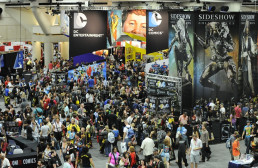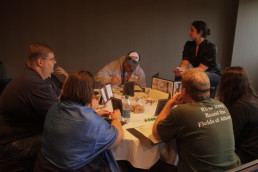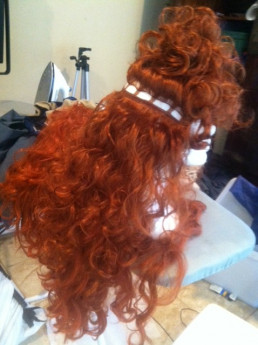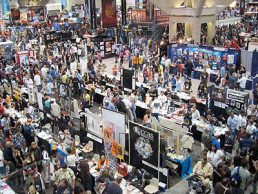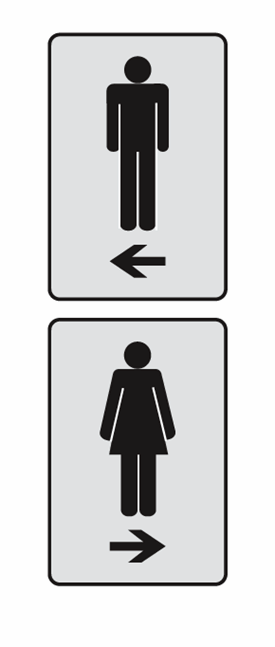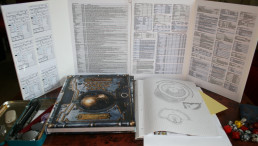Renaissance Faire Survival Guide

I have been working at renaissance faires all over the Western United States for over a decade, and attending them as a customer since long before that! They are strange, but wonderful events that capture the imaginations of all kinds of people. There is really something for everyone, but a few simple tips will help you get more enjoyment from your time at a faire.
1. Water
Alcoholic beverages are the drink that ren faires are known for serving. Imbibing can be a fun part of your day, but most renaissance faires take place in the hotter months of the year. Try to match your alcohol intake with equal amounts of water. Dehydration and overheating are the most common reasons for First Aid treatment of faire customers, especially those in costume.
2. Shoes
The average renaissance faire visitor will walk over four miles at a large faire. Most of that will be on uneven dirt paths, which make the mileage even harder on your feet. Wear comfortable, supportive shoes to maximize your fun and enjoyment. I also suggest wearing closed toed shoes because of all the dirt (sweaty feet + dirt = toe mud... eww). Sexy spike heeled boots may seem like a wonderful idea when you leave the house, but you may regret wearing them by the end of the day as you're hobbling to the exit.
 3. Map
3. Map
It's vital that you know where to find different shows, food vendors, and most importantly, the ale stands and restrooms. This will save you lots of time if you want to be on a schedule, or let you know which direction to wander if you don't have a specific destination in mind. Most faires hand out maps as you enter the front gate.
4. Privies
Commonly known as Port-a-Potties, these are one of the drawbacks of visiting most renaissance faires. They are not pleasant, but there are ways to make the experience less miserable. First, go to the units farthest from the entrance to the port-a-potty area. These are usually the least used and the cleanest. Leave most of your stuff with your friends when you go in, because you want to limit the contamination and avoid dropping things into the Privy abyss.
 5. Cash
5. Cash
Faires are a wonderful place to buy jewelry, costumes, art, and so much more directly from the artists. It's a great opportunity, however, the methods of payment that you can use may vary from booth to booth. Most merchants can accept credit card payments thanks to the magic of smart phones, but there are still a few who can't. Ale stands are usually cash-only as well, and it's good form to leave tips for servers and performers. Be ready for that and bring cash with you to avoid the crazy ATM fees and lines that happen at most faires.
6. Costumes
Costumes are one of the best things about visiting renaissance faires. You will see a huge variety of outfits, including stunning historically accurate recreations, pirates, fairies and fantasy creatures, vikings, Stormtroopers, and SO MUCH MORE! Feel free to dress up and join in the fun, but remember tip #2 from above. Costumes made from natural fibers are the best because they breath in the heat. Avoid large amounts of leather because it can get really hot, and avoid rubber at all costs!!!
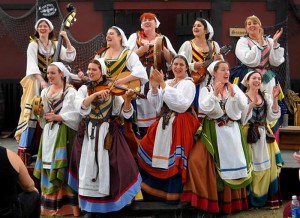
7. Shows
I'll admit, I'm a little biased here. I love performing and faire crowds are wonderful! Renaissance faire shows will have a unique feel to them and are usually very interactive. Be sure you read signs or program descriptions before you sit down to watch something, especially if you have kids with you. Some shows contain some naughty content, but usually they are clearly marked. Be sure to buy something or leave a tip at the end of the show if you enjoyed it. Renaissance faire performers work hard for their art, and are usually paid MUCH less than minimum wage, IF they are paid at all. Show your appreciation for their hard work by helping fill their gas tanks and their tankards!
8. Safety
Renaissance faires are a melting pot of different  types of people, with some alcohol and costumes tossed in for fun. They are safe, but as with any public situation (conventions, amusement parks, county fairs, concerts, etc) you need to be aware of your surroundings. Inevitably, there are those few people who will get drunk and inappropriate. They may be inappropriate with you, or with each other. PLEASE REPORT THEM TO SECURITY! You can do this by finding a security person, or by telling the nearest ale stand or booth. We work very hard to create a fun place, and we don't want our hard work to be in vain because of a few jerks.
types of people, with some alcohol and costumes tossed in for fun. They are safe, but as with any public situation (conventions, amusement parks, county fairs, concerts, etc) you need to be aware of your surroundings. Inevitably, there are those few people who will get drunk and inappropriate. They may be inappropriate with you, or with each other. PLEASE REPORT THEM TO SECURITY! You can do this by finding a security person, or by telling the nearest ale stand or booth. We work very hard to create a fun place, and we don't want our hard work to be in vain because of a few jerks.
**IMPORTANT: Remember that not everyone wearing a costume is a faire employee!!! Many people dress up and pretend that they are part of the show, but they paid for their ticket just like you. These "playtrons" are usually at the root of most behavior complaints since they are not trained to interact with the costumers. If someone in a costume is making you feel uncomfortable, be direct! Tell them to stop, then report them to security so it doesn't happen to someone else!
9. Parking
Most faire parking is a big dirt field. If you're lucky, there might be some flags or lines to help show you where to go. If you are VERY lucky, there might be some people pointing for you. By the end of the day it will ALL LOOK THE SAME!! A sea of dust covered cars is hard to navigate. Use a handy Car-Finding App if you have one, or at very least, take a picture with some stuff in the background to reference later. Trust me.
10. Open Mind
Renaissance faires are AMAZING. They are such an eclectic mixing of different aspects of the human experience. A mix of history, art vendors, concert, carnivals, reenactments, conventions, food festival, and costume party! I love it! Come to faire with an open mind, ready to experience something truly unique.
To find a renaissance faire near you, visit Renaissance Magazine's Renaissance Faire List!
EDIT: I've received some great comments on this article! Here are a few more tips!
- Wear sunscreen and reapply it during the day! Hats are your friends!
- Pack well so that your things are easy to carry. Keep an eye on your stuff!
Huzzah!
Surviving Comic-Con
 Comic-Con. Everyone, from cosplayers to comic publishers, is frantically preparing for one of the biggest pop culture events of the year. It's a huge gathering of people on the scale of Mardi Gras or the Super Bowl. Here is my list of tips to having a great time at such a chaotic event. (If you're a cosplayer, you may also want to read my Cosplay Must Haves article!)
Comic-Con. Everyone, from cosplayers to comic publishers, is frantically preparing for one of the biggest pop culture events of the year. It's a huge gathering of people on the scale of Mardi Gras or the Super Bowl. Here is my list of tips to having a great time at such a chaotic event. (If you're a cosplayer, you may also want to read my Cosplay Must Haves article!)
1. Have a Plan & Update the Plan!
Spend some time at comic-con.org and make a rough-draft plan before you even leave for San Diego. Figure out what panels are MUST-SEE for you, if there are any exciting events or meet-ups, where your favorite creators are holding signings, and where your favorite booths will be. After you have your rough-draft, highlight your three top choices for each day.
When you get to SDCC, be sure to check updates online and to check the programs they hand out for updates and changes to the schedule. Twitter is also an awesome tool for staying on top of adjustments to scheduling.
YOU WILL HAVE TO MAKE HARD CHOICES. You will never get to everything you want to see. Be prepared for this.
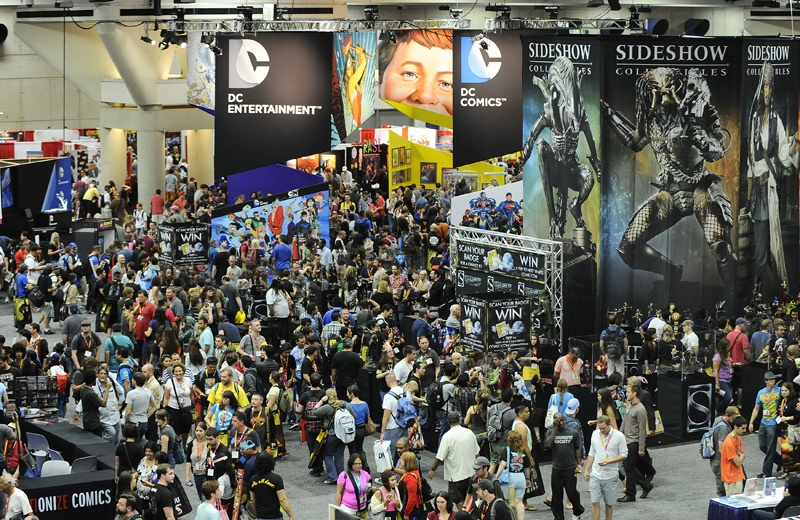 2. Bring Provisions
2. Bring Provisions
You should always carry water, food, hand sanitizer, and painkillers with you. Food and water are incredibly expensive, and you could easily lose an hour standing in line at the Starbucks in the convention center. Bring a backpack or messenger bag full of power bars, trail mix, bottles of water, candy. If your feet or head start hurting in the middle of the day it's always better to be able to deal with it immediately, and you want to avoid getting sick when dealing with the (mostly) unwashed masses.
PRO TIP: I love collapsible water bottles for conventions. They are easy to refill at water fountains and take up less space in your bag when they are empty.
I also recommend bringing a cooler of food with you to leave in your hotel, especially if you are staying anywhere near the Gaslamp district. It's much cheaper/easier to make yourself a sandwich for lunch, or have some milk and cereal in the morning than dealing with the waits and upped prices of local restaurants for every meal. Requesting a fridge is ideal, but those are usually limited and gone unless you arrive on Monday or Tuesday before the Con.
Con-Bag Check List:
- Snacks & Water
- Sharpies to get autographs
- chargers & power strip/ extra batteries
- maps
- painkillers
- hand sanitizer
- cash (many booths don't accept cards!)
- iPod/handheld gaming device & headphones to combat line boredom
- Travel stick of deodorant & mints/gum
- camera/phone that takes pictures
3. Stay Connected
The massive amounts of people really put the strain on technology at SDCC. All cell networks are stretched within an inch of their life, and it's often hard to get service in parts of the convention center. If you are splitting from your party, or want to meet up with specific people, plan it ahead of time or early in the morning before everyone starts using the network. You will waste less time if everyone knows to meet at the outside stairs at 10am, instead of texting and calling and trying to round people up on the fly.
Pack extra batteries for your camera, phone, and even your laptop if you are able. If not, be sure to bring your charger with you and a surge protector. You will be the most popular person in your line if you share the charging power with those around you. It will also guarantee that you are allowed to use the outlet, even if someone's already plugged into it. While you're in the convention center turn off GPS and other non-essential functions on your phone to save battery life. Most of that stuff doesn't work within the heavy concrete walls anyway.
 4. Be Comfortable
4. Be Comfortable
If you're a cosplayer, you're screwed. Everyone else, dress as comfortably as possible. Comfortable shoes are the most important thing. You will be on your feet ALL DAY. ALL DAY and maybe most of the evening!!! Wear something with support that is made for running or walking and be sure they are already broken in.
Dress in something that breathes (cottons, natural fabrics) so that you stay comfortable and sweat can evaporate instead of getting sticky. You will probably want to sit on the floor at some point due to exhaustion and lack of seating, so be sure your outfit can handle that. Wear a sweatshirt around your waist, even if it's a warm day. Some of the panel rooms or outside areas can get pretty chilly with the air blasting.
Bring a backpack or messenger bag to carry swag in. If you really like free stuff, bring an extra empty one with you! They bags they hand out are cumbersome and can be hard to carry in crowded areas.
5. Have A Map
Actually, have a few maps. You will want a map of the show floor and convention center. You can print these out early at the Comic-Con website or pick them up on site. A map of the downtown San Diego is really handy as well. With internet/cellular service somewhat unreliable at times, it really helps when you are trying to find events away from the convention center. These are usually available for free from your hotel, or you can print one out before you leave home.
AVOID DRIVING AS MUCH AS POSSIBLE! Walking, even to something many blocks from the convention center, will be faster since most of downtown is at a perpetual standstill. You can always hire the bike carriages that are all over the place if you don't feel like walking. If you are driving in each day, GET THERE EARLY!
6. Wear Sunscreen
It's San Diego for heaven's sake! You never know when your panel's line might end up outside, or if you'll be stuck sitting by a window. You don't want to become a french fry if the walk from your hotel takes longer than expected.
7. Be Prepared for Panels
 Panels can be a nightmare. There are whole survival guides written about attending SDCC panels, and you still wouldn't know everything that you need to know. Here are the basics:
Panels can be a nightmare. There are whole survival guides written about attending SDCC panels, and you still wouldn't know everything that you need to know. Here are the basics:
There are lines for the panels, and the more popular something is, the longer the line will be. Hall H has the longest lines (see picture of Hall H line to the right), but with good planning it is usually doable. Some people sleep overnight to get into Hall H, and rumors of famous stars visiting the line late at night abound. If you're planning to spend lots of time in the Hall H line be sure you only have one normal sized chair or sleeping bag and are not saving spots for people not in the line (bathroom breaks are ok). It is also outside, so be ready.
The big thing to know is that they don't clear the room after each panel. So people will sit through many panels to guarantee that they see the one they want in a few hours. Hell, many people just hang out in Hall H all day and never see the rest of the convention. This can be frustrating for people in line because sometimes the room hits max capacity before the whole line is allowed in. Again, if something is really popular, go early and politely sit through the panel(s) before it.
Before spending all your time trying to get into a panel, check to see if it will be posted online. It's a great way to see a panel without dealing with the crowds or when there is a scheduling conflict. You might have to do a little hunting around, but thanks to YouTube, a huge amount of panels are available to watch later. If you go to a panel and want to participate, PLEASE ASK GOOD QUESTIONS. Nobody wants to hear a rant about your feelings on their work for the last 10 years. Make sure your asking something that involves the panel topic and doesn't make the panelists hate you.
 8. Be Early For Everything
8. Be Early For Everything
Leave yourself extra time to get everywhere. No matter how well you plan your day, there will be issues that come up. This is most important with getting to and from the convention center at busy times. The shuttles can sometimes get off schedule, so catching an early one will ensure that you don't miss your favorite stuff and give you more time on the convention floor. Arrive early for signings, panels, and screenings. There are always lines and the sooner you arrive, the better chance you have of actually getting to participate.
There is no real rule of thumb for this, but it will easily take you two or three times as long to get anywhere.
9. Hygiene
There is a massive number of people at Comic-Con. I don't want to stereotype our subculture, but I've attended enough gaming and comic conventions to know better. PLEASE SHOWER EVERY DAY! PEOPLE NOTICE!! Parts of the convention center get very warm and everyone sweats. I don't care how worn out you are, SHOWER. I highly recommend packing a small travel stick of deodorant in your bag to freshen up throughout the day, especially cosplayers who are wearing bulky or heavy outfits. Please also be sure to brush your teeth daily since you will most likely be conversing with other humans at some point. Mints or gum are a great way to stay fresh throughout the day.
By Sunday, many parts of the convention center develop a distinct odor. If you're not part of the solution, you are part of the problem.
10. Interacting with Cosplayers
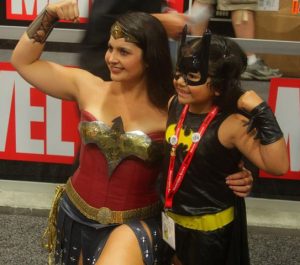 The people who are dressed in costume are called "cosplayers," and they are people too. In fact, they are fans just like you! They are not paid by the convention, and they buy their tickets and hotel rooms just like everyone else. Cosplayers are there to enjoy themselves, not to entertain you. Be respectful. They come from all walks of life and you never know when a cosplayer might be an off duty cop with a passion for sewing. DO NOT TOUCH A COSPLAYER WITHOUT ASKING FIRST! COSPLAY DOES NOT EQUAL CONSENT!
The people who are dressed in costume are called "cosplayers," and they are people too. In fact, they are fans just like you! They are not paid by the convention, and they buy their tickets and hotel rooms just like everyone else. Cosplayers are there to enjoy themselves, not to entertain you. Be respectful. They come from all walks of life and you never know when a cosplayer might be an off duty cop with a passion for sewing. DO NOT TOUCH A COSPLAYER WITHOUT ASKING FIRST! COSPLAY DOES NOT EQUAL CONSENT!
Most cosplayers do love to pose for pictures because we are incredibly proud of the outfits we have made and love the characters. It's always great to meet another fan and very flattering to be asked for a photo. Ask first, and it's always great to have you pose in the picture with us. If you are planning on posting the picture online, please talk to the cosplayer about it first. Most have Facebook pages or DeviantArt pages that you can easily credit.
Be careful of our costumes! We put hundreds of hours and often hundreds of dollars into making them. Some pieces may look very sturdy, but often they are very fragile. Grabbing something or touching something can seriously damage it. Ask before grabbing a prop to pose with or before putting your hand on their shoulder armor.
11. Have Fun
Comic-Con is an amazing experience, and a yearly tradition for many fans. The most important thing is that you enjoy yourself. Take time to soak in the experience and appreciate how cool it is to have so many geek brothers and sisters all in one place!
Batgirl's Doctor is In: Dr. Andrea Letamendi
 Andrea Letamendi is one of the most interesting figures on the convention scene. She holds a Ph.D. in Clinical Psychology, and puts her knowledge to geeky use by speaking about the psychology of Superheroes, Science Fiction, and Cosplay. When she isn't speaking on panels, Andrea works as a researcher at UCLA, does work for Marvel and DC, and creates amazing cosplays of her own.
Andrea Letamendi is one of the most interesting figures on the convention scene. She holds a Ph.D. in Clinical Psychology, and puts her knowledge to geeky use by speaking about the psychology of Superheroes, Science Fiction, and Cosplay. When she isn't speaking on panels, Andrea works as a researcher at UCLA, does work for Marvel and DC, and creates amazing cosplays of her own.
Kimi: You’re known as @ArkhamAsylumDoc on twitter, do you have a favorite Arkham inmate in the Bat-verse?
Andrea Letamendi: Oh yes, I have many favorite Arkham Baddies. I can’t deny the power that the Joker has psychologically–he is such a mesmerizing and puzzling character because his acts of villainy and destruction do not always seem rationale or explainable. My favorite villain from Gotham’s Rogue Gallery is the Penguin, because of his tragic story. He seems to frequently try to reach out and connect with others, perhaps just looking to be understood, and that is incredibly relatable.
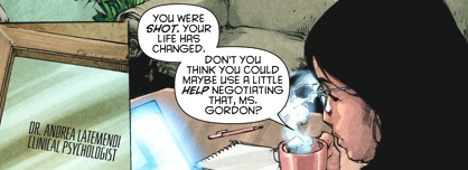 K: You were recently depicted in Batgirl #16 as Barbara Gordon’s clinical psychologist. Why did Gail Simone immortalize you as part of DC cannon?
K: You were recently depicted in Batgirl #16 as Barbara Gordon’s clinical psychologist. Why did Gail Simone immortalize you as part of DC cannon?
AL: Last year, before the Batgirl annual, Mrs. Simone reached out to me to ask some questions about trauma recovery. Essentially she was writing about an important time in Barbara’s life during which she was recovering–both physically and psychologically– from the severe injury from a gunshot wound when the Joker attacked her (See: The Killing Joke). As a Batgirl reader and DC fan, I was more than thrilled to answer anything she wanted to know. My background in treating soldiers who have returned from Iraq and Afghanistan with psychological and physical injuries best prepped me to give anecdotes and explain the relationship between the therapist and the healing client. Little did I know that Mrs. Simone would not only write some of my suggestions into her comic, but also include me as a character! It was truly a surprise– and I feel the honorary gesture was not just toward me but for the psychology community as a whole.
K: In addition to being an adviser for Marvel and DC, you are also well known as a cosplayer. What pushed you to start cosplaying?
AL: I have essentially been cosplaying since I was a teenager, if you count “dressing up as a Jedi character that you made up” cosplay. I’ve always felt drawn to dressing up as characters I love, but it truly wasn’t until I started attending conventions in 2006 that I initially became involved with cosplay and the cosplay community.
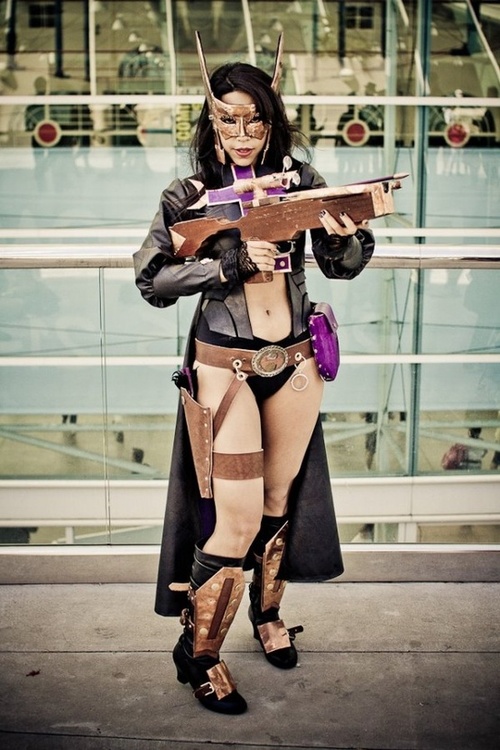 K: Which costume is your favorite to wear to conventions?
K: Which costume is your favorite to wear to conventions?
AL: My favorite costume is probably my Steampunk Huntress costume, although I have a Battlestar Galactica costume in the works and it may quickly become one of my favorites!
K: You’ve found a way to bridge the gap between your love of psychology and your love of comics, are you trying to do the same with psychology and cosplay?
AL: I’ve found that my love of cosplay has led me to ask questions like “what draws us to certain characters?” and “why do we feel fulfilled or content when we’re wearing someone else’s clothes?” I also believe there’s something empowering and psychologically inspiring when we dress up as a superhero that we look up to, even if they are fictional. In my mind, it was inevitable that these two universe’s collide, which is why me and my colleague created a Cosplay Survey and plan to continue exploring the motivations, expressions, and backgrounds of cosplayers. I also believe that we can use real-world data to debunk or disconfirm myths about cosplayers. I feel as though psychological science can tell a story that allows people to see how adaptive, healthy, resourceful, and social cosplayers really are.
K: What conflicts have you faced between your geeky hobbies and your career?
AL: Actually, even though I initially felt distanced and a bit misunderstood in my field, I’ve recently discovered that people are generally interested–and even quite inspired–by some of the work I’m doing in the comics and cosplay community. I have to say that I was surprised by this and it reminds me that people just want to get to know you and that the field of Psychology can be particularly open and supportive of these other hobbies. I’d like to think that goes with other social sciences disciplines.
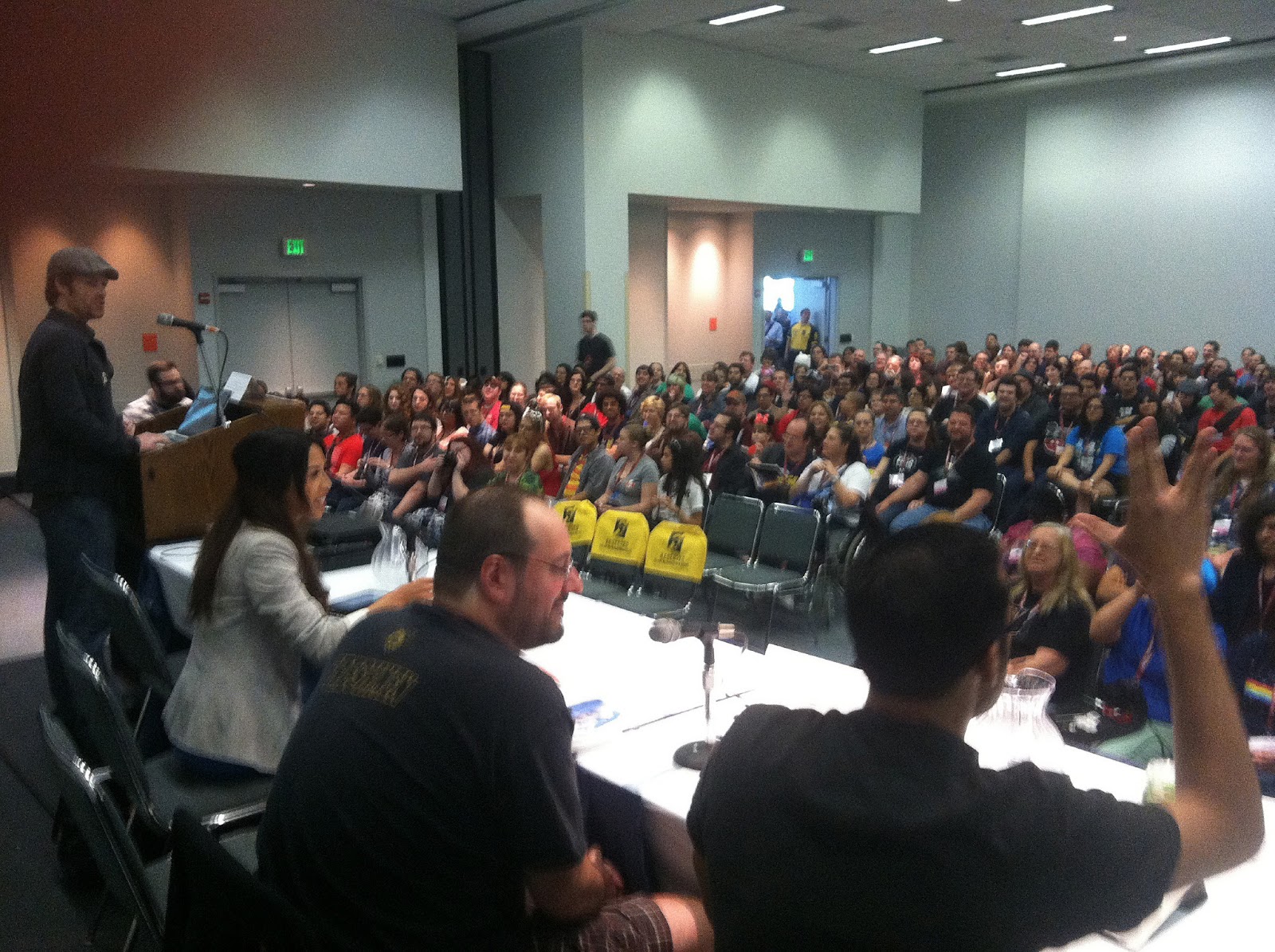 K: Briefly, what have you learned about the Cosplay community through your surveys and your Psychology of Cosplay panels?
K: Briefly, what have you learned about the Cosplay community through your surveys and your Psychology of Cosplay panels?
AL: We have learned that cosplayers represent a very diverse and social group. I think the single most important thing we have learned is that we simply do not have any evidence that cosplayers share any one feature or characteristic beyond their passion for costuming and performing. Stereotypes about cosplayers, therefore, are not currently supported by anything other than bullies on the internet.
You can visit Andrea's blog at Underthemaskonline.com or follow her on Twitter @ArkhamAsylumDoc.
Dealing with Player Ignorance

I have GMed many convention games, but I ran into a new problem a few months ago. One of the players in my game had a fundamental misunderstanding of a pretty simple scientific principle. I will not go into specifics because I do not wish to embarrass that player or narrow down which game I am discussing.
The players were engrossed in the game and having a blast trying to come up with a solution to my challenge. They were all great people and it was a very positive game, however suddenly one of them suggested an action that defied the laws of physics. Two other players jumped on board, and the remaining players looked at me with their eyebrows raised.
I casually asked for clarification, hoping they'd catch the mistake themselves. No luck, so I very politely questioned their logic, asking if that was really what they meant to say. Surely, their basic elementary school knowledge was just a little rusty, right? Wrong. They defended their position, restating their faulty understanding of earth science. The logic behind their actions was sound, they just didn't state the right materials to do what they wanted. I was at a crossroad, do I impose my scientific understanding on the game to insure it's correct and risk embarrassing the player, or roll with it and prioritize fun over academic correctness?
Against ever instinct in my teacher body, I rolled with it. Why? Well there were two main reasons.
First, I didn't want to penalize the characters for the players' ignorance. They had found a good solution, but simply did not have the scientific background to choose the right materials to make it work, even though the materials were available to them. Often we play characters with knowledge or qualities different than our own. Shy players can roll skills to give speeches and technology dummies can roll to hack computers, so it didn't seem fair to kill their creative idea when their character would have known exactly the right material to choose.
More importantly, I didn't want to kill the fun. It was a one shot game with people I didn't know well. If it had been my normal gaming group, I might have argued the point and then bought the player a beer. I didn't know these players well enough to push them. They might have gotten mad and walked away, or been perfectly polite but not enjoy the rest of the game. We were all there to have a good time and it seemed pointless to risk that over a small mistake in their plan. That said, if this had been a campaign I would have pressed the point because I wouldn't want the physical laws of my universe to be altered long term, but again, I would know players in a campaign game enough to debate it with them.
Did I make the right choice? I still ponder that question. The game finished smoothly and everyone seemed to enjoy themselves, but maybe they would have enjoyed themselves if their plan had failed. It really boils down to an individual's personal goals for the game. Mine was for my players to enjoy themselves, and I succeeded, but I might not make that same choice again.
Oh, and after the game I casually brought it up to the player privately and suggested they look it up when they got home. The teacher side of me couldn't give up completely.
The Geek Girl Problem
 The problem with the geek girl subculture is the unrelenting expectation of uniformity.
The problem with the geek girl subculture is the unrelenting expectation of uniformity.
I have seen countless articles and posts about the problems with the geek girl subculture. Some are written by geek girls and some are simply commenting on us. Many cast stones at select groups of female geeks for a huge variety of transgressions. Girls are too sexy, not sexy enough, too specialized in their interest, not specialized enough, too fake, too judgmental, too obsessed, not obsessed enough, too mainstream, too antisocial, too popular, not popular enough, and on and on and on. Somehow, people have the idea that if geek girls took their specific advice, we will become a unified army of geekdom.
Are you flipping kidding me? REALLY? Despite our different backgrounds, ethnicities, body types, religions, knowledge, skills, and interests, we are expected to share the same point of view because we have vaginas?
Geek girls are free to dress up as Wonder Women at every convention they can get tickets to, and other geek girls are free to think that they are disrespecting themselves by showing off so much skin. Who has the right to judge others for their opinions? You did no share their excitement at getting a Wonder Woman lunchbox in 2nd grade, or their deeply religious upbringing in a small town. Hopefully both sides behave themselves and respect the other geek's freedom of choice, but neither is better or worse for their opinions, and neither should be expected to change their minds due to peer pressure.
 This uniformity expectation also applies to geek knowledge. We keep banging our heads against the misogynistic opinion that there are only a few "real" geek girls, and the rest of us are using geekery to get male attention. Once again, in spite of our innumerable differences, women are all expected to be experts in every aspect of geek culture to PROVE that they are geeks. I have seen it time and time again, especially at public events and conventions. Usually, it's in the form of a seemingly innocent question about a geeky topic. If the girl fails to answer correctly, *POOF* there goes all her credibility. Suddenly, the woman who spent 74 hours sewing a cosplay outfit, 9 hours in line for a panel, four days writing a Dr. Who blog post, $200 a month on comic books, or maybe is just visiting her very first convention, is lowered to the level of attention-seeking "fake" in the mind of the quizzer (who can be male or female).
This uniformity expectation also applies to geek knowledge. We keep banging our heads against the misogynistic opinion that there are only a few "real" geek girls, and the rest of us are using geekery to get male attention. Once again, in spite of our innumerable differences, women are all expected to be experts in every aspect of geek culture to PROVE that they are geeks. I have seen it time and time again, especially at public events and conventions. Usually, it's in the form of a seemingly innocent question about a geeky topic. If the girl fails to answer correctly, *POOF* there goes all her credibility. Suddenly, the woman who spent 74 hours sewing a cosplay outfit, 9 hours in line for a panel, four days writing a Dr. Who blog post, $200 a month on comic books, or maybe is just visiting her very first convention, is lowered to the level of attention-seeking "fake" in the mind of the quizzer (who can be male or female).
Our knowledge on any subject, geek or not, is going to be as varied as our skin color or favorite foods. I hate to break it to everyone, but there aren't merit badges for knowing more nerd trivia than everyone else. Go ahead and whip out your geek fanboy (or fangirl) penis and prove it's the biggest in the room. It's the geek version of driving an inconveniently huge truck or car, everyone knows you're compensating. Judgmental showing off only drives people away from the culture. Ask yourself honestly, is that your goal?
There is no problem with geek girls, the problem is with geek girls not being accepted and respected for who they are as individuals. People desperately want to belong to a group. Sadly, the easiest way to do that is to exclude others. As geek culture rapidly becomes pop culture, we have to embrace the diversity that inevitably comes with a surge in population. Old stereotypes have to change to accommodate new faces, new interest levels, and new ways of expressing one's passion.
If Whovians, tabletop gamers, video gamers, comic readers, Trekkies, Potter Heads, Guildies, LARPers, and so much more are considered "geek," than surely there is room for a huge diversity of women to be considered "geek girls". We ALL have the right to march in the geek parade, even if we don't all march to the same drum... or trumpet... or tuba... or baton... or agree there is a parade at all...
Do-It-Yourself: Merida Wig (from Brave)
 Merida is the high-spirited new princess from Disney/Pixar's new movie, Brave. One of her defining features is her amazing curly red hair. It took Pixar artists over three years to perfect the program that created Merida's trademark locks. It's the single most identifiable part of any Merida costume, and a huge challenge to create.
Merida is the high-spirited new princess from Disney/Pixar's new movie, Brave. One of her defining features is her amazing curly red hair. It took Pixar artists over three years to perfect the program that created Merida's trademark locks. It's the single most identifiable part of any Merida costume, and a huge challenge to create.
The biggest challenges for the wig were the specific shape and size, color and highlights, varied textures, and movement. After doing lots of internet shopping I decided that a single, store-bought wig would never achieve the look I wanted. As always, cost was a factor and I was not willing to buy a custom wig for my Merida cosplay, so I started researching and figuring out how to make one of my own.
I decided that combining multiple wigs would be the best course of action. I specifically bought three different wigs so that the hair wouldn't match perfectly. Normal hair has different texture and coloration throughout, and I hoped to mimic this look. In the end this was very successful and the final product ended up looking much more lifelike (other than it's crazy size) due to the variety in it. One was a very high quality wig (they will usually cost between $40 and $60 depending on where you shop) and the other two were cheaper costume wigs (usually around $20). Look for sales, used wigs, or outlet stores to save more money. You want the colors to match very closely, but if there is a shade or two difference between them it will still appear natural. 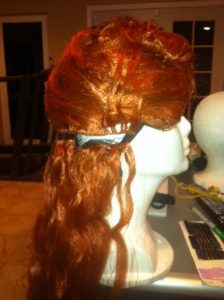
Step 1: Take the cheaper wigs apart. This is a mind-numbingly repetitive and slow process. Basically you use a seam ripper to carefully detach the strands of hair from the headpiece. As you can see in the picture to the right, the hair in most wigs is attached in rows. Clip most of the wig up on top of the foam head and start removing these rows from the back neckline. Be careful to keep these rows as intact as possible so it is easier to restitch them back onto the main wig. You just want to remove the stitches that attach the rows to the elastic/skull cap, not the stitches that keep the row of hair together.
PRO TIP: Start at the bottom back and stack the rows of hair neatly as you go. Then you will be able to sew them onto the same area on the new wig and the will be about the right size row and length.
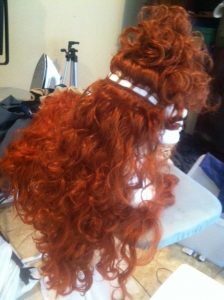 Step 2: Sew the hair, by hand, onto the higher quality wig. It's important to use a higher quality wig for the base so it is comfortable and fits well. It will stay on your head more easily and look more realistic. The cheaper hair will look better if it is mixed in with high quality hair. Sewing hair to a wig is very similar to removing it. Use a hair clip to pile most of the hair on top of the foam head, and start reattaching hair at the back neckline. As you can see in the picture to the right, the higher quality wigs have more elastic in them so they can adjust more precisely. You want the hair to be straight between each strip of elastic, but don't pull it tight. If it's too tight, the wig will not stretch properly to fit on your head. Just stitch it where it lays naturally on the foam head. You will stitch the hair to the elastic strands in the wig, NOT TO THE OTHER HAIR!
Step 2: Sew the hair, by hand, onto the higher quality wig. It's important to use a higher quality wig for the base so it is comfortable and fits well. It will stay on your head more easily and look more realistic. The cheaper hair will look better if it is mixed in with high quality hair. Sewing hair to a wig is very similar to removing it. Use a hair clip to pile most of the hair on top of the foam head, and start reattaching hair at the back neckline. As you can see in the picture to the right, the higher quality wigs have more elastic in them so they can adjust more precisely. You want the hair to be straight between each strip of elastic, but don't pull it tight. If it's too tight, the wig will not stretch properly to fit on your head. Just stitch it where it lays naturally on the foam head. You will stitch the hair to the elastic strands in the wig, NOT TO THE OTHER HAIR!
When you are done stitching, try it on to make sure that it still fits. If it doesn't, you will have to remove the hair you added and try again. Seriously, don't sew it on too tight.
Step 3: Styling the huge wig. This is the most stressful part because you can really mess up wigs if you aren't careful. NEVER STRAIGHT BRUSH A CURLY WIG. You can really mess it up. Carefully shake it or bounce it up and down to give it life or use your fingers to remove tangles carefully. Wig spray can be very helpful to keep tangles down since it reproduces the natural oils that we make for our hair. It also makes the hair look more shiny and real.
 To get the volume and shape of Merida's hair, I had to do a lot of teasing around the sides of the head. Teasing hair is very counter-intuitive, because you are basically creating strategic tangles in the hair to make it stand farther from the scalp. Again, clip the hair at the very crown of the wig up and out of the way, you only want to tease hair that will be hidden by it later. Take a small section of the remaining and pull it straight up from the wig, then brush BACKWARDS from the about half way up the strand towards the roots. Use a round bristle brush and lots of hairspray to make it easier. Short, quick strokes are best. This obnoxious YouTube video can show you much better than I can describe it, but just watch the first 30-40 seconds of it to get the idea. With a curly wig, the most important thing is to make sure you put the teased areas UNDER non-teased hair, so plan well! You don't want it to show and you can't just brush the hair smooth like you can with real hair. You might want to practice on a cheap wig or your own hair before you try on your main wig.
To get the volume and shape of Merida's hair, I had to do a lot of teasing around the sides of the head. Teasing hair is very counter-intuitive, because you are basically creating strategic tangles in the hair to make it stand farther from the scalp. Again, clip the hair at the very crown of the wig up and out of the way, you only want to tease hair that will be hidden by it later. Take a small section of the remaining and pull it straight up from the wig, then brush BACKWARDS from the about half way up the strand towards the roots. Use a round bristle brush and lots of hairspray to make it easier. Short, quick strokes are best. This obnoxious YouTube video can show you much better than I can describe it, but just watch the first 30-40 seconds of it to get the idea. With a curly wig, the most important thing is to make sure you put the teased areas UNDER non-teased hair, so plan well! You don't want it to show and you can't just brush the hair smooth like you can with real hair. You might want to practice on a cheap wig or your own hair before you try on your main wig.
Curling wigs is a pain. If possible, always buy wigs already curled the proper amount. You cannot use curling irons or any heated hair styling tools on most wigs. The wigs I purchased were pretty curly, but there were a few strands that were sticking out oddly when I finished teasing. To amend this, I used old-fashioned plastic curlers (the ones that have foam and then clip shut) to wrap these strands and then CAREFULLY dipped them in boiling water for about thirty seconds. Be very careful to not dip non-curler hair in the water because it will straighten it, and don't burn yourself! After dipping them, carefully run just the curler hair under cold water. Having a second 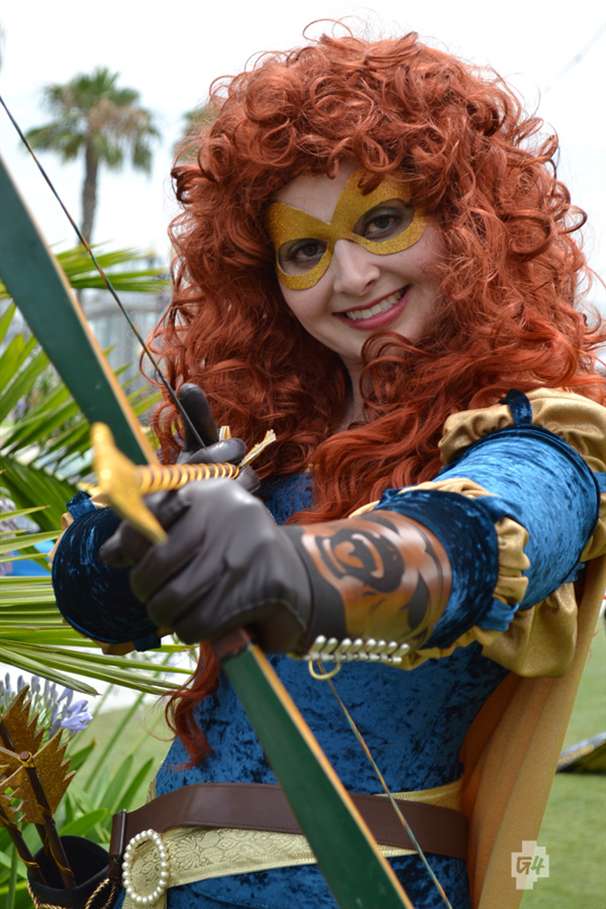 person to hold the wig head and extra hair is very helpful if you try this method of curling. Once the curlers have been dipped in cold water, carefully unwind them from the curlers and let them dry. Once they are dry, hairspray the heck out of them! I chose to use a few different sizes of curlers to give the same variety of curl size that Merida's hair has, and you may want to use the same trick if you are trying to recreate natural curls.
person to hold the wig head and extra hair is very helpful if you try this method of curling. Once the curlers have been dipped in cold water, carefully unwind them from the curlers and let them dry. Once they are dry, hairspray the heck out of them! I chose to use a few different sizes of curlers to give the same variety of curl size that Merida's hair has, and you may want to use the same trick if you are trying to recreate natural curls.
Step 4: Wear it! I was very happy with the final product, but I may add even more hair to it before next time! I saw a LOT of Merida cosplayers at San Diego Comic-Con and the wigs were what really set the good ones apart. In cosplay, size does matter.
10 Convention Necessities for Cosplayers
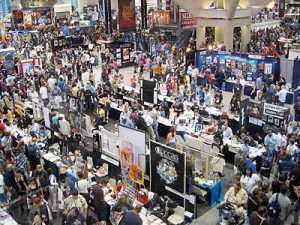 Cosplaying completely changes the convention experience. The crowds, schedules, lines, and costs are only more stressful once costumes are added to the mix. Here is a list of "must-haves" that will make your cosplay experience easier.
Cosplaying completely changes the convention experience. The crowds, schedules, lines, and costs are only more stressful once costumes are added to the mix. Here is a list of "must-haves" that will make your cosplay experience easier.
1) Emergency Repair Kit
This is a large kit that you keep in your car or hotel room for the length of the convention. It should include a sewing kit, duct tape, fashion tape, a hot glue gun, industrial glue, masking tape, permanent markers or touch-up paint in the colors of your costume and props, stain remover, and fabreeze. Crazy things happen at conventions and it's best to be prepared for anything.
2) Business Cards
These make a cosplayer's life a lot easier. Nobody wants to take time to spell out their Twitter handle or email address in the middle of the busy convention floor. You don't have to spend money on these. Even if you just write your contact info on a bunch of post-its ahead of time, photographers and other cosplayers will really appreciate it.
PRO TIP: Be careful not to put your personal phone number or full name on these cards, unless you are willing to deal with stalkers showing up at your house. Set up a cosplay email account if your email address includes your last name... or if you have a crazy complicated email address.
3) Pockets
Pockets are one of the most difficult things to build into a costume, especially women's costumes. A place to store your cell phone, your ID, and a credit card are worth more than gold when it comes to working the convention floor. Whether it's a hidden pocket glued into the top of your go-go boots, a small matching bag that you make out of extra fabric, or a significant other who is willing to follow you around with a backpack, it is vital that you have a way to transport your stuff. Make sure you at least have your ID somewhere on you in case something happens.
4) Floor Kit
This is the mini version of your emergency repair kit and should go with you around the convention. I highly suggest fashion/2-sided tape (the pre-cut strips are best), small tube of super glue, eyelash glue, and lipstick are the musts. If you have room in your bag or pockets, I also suggest masking tape.
5) 3 Different Poses
You will get asked to pose for pictures so put some thought into it before you arrive at the convention. Photographers will usually shoot a few pictures in a row, but they will lose interest faster if you stand frozen in the same pose for all of them. Try to hold a pose for a few seconds, then switch it up. Practice poses at home in front of a mirror, or have a friend shoot pictures of you. Most people at conventions are not professional photographers and they will do you no favors by setting up the shot or making you look good. Practice makes perfect!
6) A Posse
Conventions are big places where all manner of people are shoved into a high stress environment together. If you can, attend a convention with friends or other cosplayers. They will hold your props while you stand in the bathroom line, help keep an eye out for up-skirt camera pervs, and take pictures of you when you see your favorite celeb.
7) Snacks & Water
Dehydration and empty stomachs can ruin your day very quickly. It's easy to forget to take care of yourself when you are caught up in enjoying yourself. Suddenly you realize that you haven't eaten in six hours and the line for the nearest food is 45 minutes long. Have a granola bar hidden somewhere on your person. Water is harder to transport (and bathroom breaks are a pain in some costumes) so be sure you hydrate extra in the days leading up to the convention.
8) Gum or Mints
Conventions are crowded. Bad breath sucks. Enough said.
9) Costume Check List
These will help you get your entire costume to and home from the convention. Nothing sucks more than getting dressed and realizing that the amazing belt buckle that you made is still on your sewing table. It's even worse when you realize that you left a vital part of your cosplay at the hotel when you were in a hurry to head home. A check list makes sure every little bit stays with you. It's worth the extra effort.
10) A Plan
Conventions are becoming very popular. Parking, tickets, hotel rooms, and panel lines can be a real nightmare. Trust me, there is NOTHING worse than showing up for a convention in costume and figuring out that the only open parking is six blocks away. Do your research ahead of time. Know where the parking is and how much it costs, buy your tickets days or weeks before, and know the costume and prop rules for the event. It will save you a lot of time, stress, and disappointment in the end.
Comprehending Cross-Gender Characters
Cross-gender role-playing can be a controversial topic at the gaming table. Opinions are as varied as one could imagine and while some gaming groups are very open to cross-gender characters, other groups are flat out against it. So why is something that has been around since role-playing began such a big deal?
Women are partially to blame. The number of female tabletop gamers has been growing for many years and co-ed games can make people uncomfortable with portraying the opposite sex. After I posed the question on Twitter, one man likened it to faking a British accent with a British person at the table. The pressure to "do it right" can take a lot of the fun out of role-playing, even if the other players at the table aren't judging you. I was very worried about portraying a man "right" the first time I cross-gender role-played, and it showed. It was our third or fourth session before I really hit my stride and stopped second guessing myself before speaking. I've seen the same thing happen with men playing female characters. Social pressure can paralyze a person's creativity and role-playing ability.
Everyone worries about being judged by others, and good communication is the key to insuring that everyone enjoys your game. If you are worried about insulting a person in your game by portraying the opposite sex, warn them ahead of time. Please notice, I didn't say to ask permission, because only the GM should have the power to veto a character concept. Just give the other player a heads up, and if it's your first time playing a cross-gender character, maybe ask for some tips. In my experience, it doesn't matter if you screw up from time to time. If it's obvious you are really trying to create a cool character most people will be very supportive.
Sadly, there are those people who seem to play cross-gender characters just to make other players uncomfortable. I have seen this happen with players of both genders, but I think it's more common for women to be upset in this way. Usually, this happens when you are in a gaming group of people that you don't know well. Now, really insulting a normal, reasonable gamer is harder than you'd think. Playing an unintelligent woman who loves shoes isn't necessarily insulting to women (or original), but playing an unintelligent woman who trades sexual favors for shoes every time the party stops in town is something else. The difference is that the player is taking a specific action to demean the character in a way that relates to their gender. As a woman, I can forgive someone for playing a little bit of a stereotype. I cannot ignore someone treating a female character as a sausage wallet to satisfy their own sexual or misogynistic fantasies.
If you are uncomfortable in a game talk about it. Ninety-seven percent of gamers are great people who are not setting out to insult you. Usually if you can have a calm conversation they will try to fix things in future games. If you are not comfortable speaking directly to the other player or if the other player doesn't agree with you, speak with your GM. You are as important as any other player at the table and if someone's role-playing is making you uncomfortable, it's important that the situation is fixed. Be logical, non-judgmental, calm, and have the first conversation in private. Nobody likes to have their mistakes pointed out in front of their friends, so having the approaching them in private increases your chances of really being heard. Also, take action immediately when something unacceptable happens at the table. Get in touch with the player or GM after the session or when your group takes a dinner break. If you say nothing, you are setting the precedent that things of that nature are acceptable. It's sad that some boundaries need to be pointed out, but to be perfectly honest, some gamers need help with social cues and understanding that some actions aren't ok, even if they fit with their idea of a character. (Sheesh, there I go stereotyping...)
What is the most important thing to remember about playing with cross-gender players? Relax. Don't try to psychoanalyze them. It doesn't mean that they are homosexual, have penis/vagina envy, mommy issues, need to get laid, or anything else. Most players just try it as a change of pace or for a new challenge. If you aren't interested in playing a cross-gender character, fine, but be open minded with those who want to try it. The purpose of gaming is to enjoy ourselves. Some of us do that by playing characters very similar to our real selves, some of us love to try out completely different personalities for a few hours. Whatever your preference, the purpose is for everyone to have fun! It is a game after all.
(This article was originally posted on CharismaBonus.com)
Jumping into GMing

GameMASTER. The title itself has a way of excluding about half the population, and that fact is reflected in every game shop and on every convention floor. The number of female gamers may be rising, but the number of female GMs is still pathetically low by comparison. This has to change if we are going to continue to grow as a demographic.
GMing is something that every gamer should do at least once. It's an incredibly educational experience, and even if it doesn't end up being something that you stick with, you will be a better gamer for giving it a try. I was terrified the first time I ran a game, and consequently over prepped my game. It was a 4e game, based in a fantasy ocean world that I created called Nenesto. I had such a blast coming up with the NPCs, the cultures, and the challenges! I completely fell in love with the creative process and the power... THE POWER!! MWAHAHA... ahem. To date, I have run more than twice as many convention games as I have played in. Once the GMing bug bites, it doesn't let go, girls!
I have never run an adventure path or company published scenario for a group of players. I know that a lot of GMs start this way, and it can be very enjoyable. I've had a blast playing in many published campaigns, but I find that it is harder to run a game like that than just create my own world. No, I'm not crazy. Actually, I would argue that it would be easier for most people once they got over their fear of trying. Think back to when you were a kid. You had to study and practice the information that people gave you to learn, but you always could remember the smallest details about the stories, games, and worlds that you dreamed up yourself. It's much the same with self-created gaming worlds. I created the details of the world, so it's harder to forget them or mess them up... and if for some reason I do mess up, it's really easy for me to change to world to accommodate my mistake.
But how does one start to attempt such a daunting task as creating a game from scratch? First, you need to find a group of (kind) players. I was lucky enough to already have a gaming group that encouraged me to try GMing, but if you aren't so lucky, try recruiting friends and family members. Even if you end up running a game for two people who aren't gamers, it will be great practice and break the ice for you. Actually, running your first game for non-gamers has it's advantages. They are less likely to notice your mistakes, and you get a lot of practice explaining the system mechanics to them. I do not recommend running your first game for a group of strangers at a gaming store or convention, because you never know what type of players you will get.

After you have your players, pick your system. It should be a system that you are pretty familiar with, ideally one that you have played a lot. I recommend this because the more you know about the mechanics of a system, the easier it will be to tailor a good story around it and keep your game running smoothly. Have most of the basic combat and skill stuff memorized or on cheat sheets so you don't waste your players' game time looking stuff up. Cheat sheets are your friend! I'm convinced that's why the GM screen was originally invented. Another great trick is to have more obscure combat rules other important information marked so you can easily find it. Your mind will go blank at some point and it's great to be able to quickly find that info. My Wild Talents book is covered in multicolored sticky tabs for this very reason. Your players will appreciate your efficiency and be impressed that you are so prepared. Make no mistake, they will always do the one thing that you can't remember the mechanic for... darn players!
Step three, create your world based on something you know and love. Most likely the system you picked has errata with details about races, monsters, kingdoms/cities, etc. Feel free to use it or lose it. Don't feel that because you are running a DnD game that you HAVE to have dwarves, elves, and all the usual DnD suspects. Maybe your world only has humans, or maybe it takes place completely underground in the dwarven cities. It is YOUR world. Also, don't be afraid to go in a completely different direction than the game designers intended. One of the most successful games I have ever run was a Wild Talents game (a superhero system) about the Salem Witch Trials. The poor puritans started developing powers and panicked because they assumed it was the devil's work. What made it so great? I picked something I knew well and was passionate about. I'm a history teacher by day, and my love for the setting made the players equally passionate. You know your game is a success when they are standing up in the middle of a convention room yelling at each other completely in  character, and completely oblivious to the other games around them. It's those moments that I live for as a GM. Do you know everything about Tolkien's elves? Are you a huge Firefly fan? Could you write encyclopedias about vampires in your sleep? Those will be your most successful games. (This also comes in handy when you have a really knowledgeable player! One of my players for the Salem game had recently taken a class on the Witch Trials, so it was a good thing I knew my stuff!)
character, and completely oblivious to the other games around them. It's those moments that I live for as a GM. Do you know everything about Tolkien's elves? Are you a huge Firefly fan? Could you write encyclopedias about vampires in your sleep? Those will be your most successful games. (This also comes in handy when you have a really knowledgeable player! One of my players for the Salem game had recently taken a class on the Witch Trials, so it was a good thing I knew my stuff!)
After you have your system and your world imagined, start refining it into a (somewhat) linear plot. Just like writing stories, start with a basic outline and then slowly add in the details. For your first time, stick to a one-shot game that can be completed in four to six hours. Remember, the world that you created can be used again and again so all that prep isn't a waste for one game. Your adventuring party might save a specific kingdom from a demon, but there are many more kingdoms for them (or other players) to explore! Don't feel like you have to cram all of your creative material into one game. Keep it secret, keep it safe, then use it later.
I will be providing more helpful advice on GMing specific types of games in future posts, but the first step is always the hardest. Don't be afraid to "borrow" ideas from your favorite source material and realize that you will make mistakes, and that is ok! Be secure in the knowledge that EVERY GM screws up sometimes, and jump in with both feet.
(This article was originally posted on CharismaBonus.com)
Acquiring Accents for RPGs
 Accents are one of the most powerful tools in a role-player's arsenal. Using them can make characters stand out at the gaming table, and differentiate between in character and out of character comments. They can also be the difference between a good GM and an incredible GM who truly immerses players in their world. Why narrate a story? Bring out your inner thespian and BECOME your story.
Accents are one of the most powerful tools in a role-player's arsenal. Using them can make characters stand out at the gaming table, and differentiate between in character and out of character comments. They can also be the difference between a good GM and an incredible GM who truly immerses players in their world. Why narrate a story? Bring out your inner thespian and BECOME your story.
First of all, research whatever accent you'd like to try, or shop around for an accent that you can mimic fairly well. One of the best tools for listening to accents is the internet, specifically videos. Search for "regional dialect meme" on Youtube and you will get a ton of options from all over the world. This meme is particularly helpful because it includes many words and sounds, but it also includes regional terms. For example, is it "soda" or "pop"? These terms can be awesome little details to add to your characters and really unify a group of characters that are from the same place.
Remember, it's ok if you aren't perfect at first, and you really will get better as you go. Hell, it's an RPG! Unless you are playing a historical game, who's to say your accent isn't perfect? Maybe the people from that land over the mountains sound exactly like your bad Jamaican accent. There are a large number of Russian/Irish accented characters in my games... who start to sound more Irish as I drink. Go fig.

Accents are regional, not racial. In a recent season of the Happy Jack's RPG Podcast, another host started speaking like a southern character from one of our games. The character was named Windy Drawers, and he was a sloppy, overeating, unintelligent politician. We instantly started receiving angry emails from people who were upset that we were depicting such an unflattering African American stereotype on our show, however we had never mentioned Windy Drawers' race on that episode of the podcast. In our game he was actually a rich southern white man, but listeners drew their own conclusions based on their own racial stereotypes. Let me say it again, accents are regional, not racial. They are determined by where you grew up and lived, not by your ethnicity or species.
This is a very important distinction that is often overlooked in gaming... and in the media. The stereotypical dwarf may have a Scottish accent, but if he was raised by elves (oh, the horror!) he will sound more like an elf than his dwarf kinsmen. Humans from different parts of the world should have different accents, and drow should not sound like surface elves... unless they were raised together! A good player or GM will use this in their games. An NPC shows up claiming to be from a local town, but speaks differently than everyone there... clue #1 for the party. Maybe it's your half-elf's first adventure with this band and you're getting to know them along the way? Your Irish/British/Russian/common accent tells them that you were raised by the human side of the family, not the elves. They add depth and complexity to a character instantly, that could only otherwise come from sharing written back stories or long in-game explanations.
Here are some easy tips for mastering an accent:
- Find a phrase that will immediately bring you back into your accent. Usually, this is something very stereotypical that you almost can't imagine being said in any other accent. For my Irish accent I use the phrase "Jesus, Mary, and Joseph!" because it's VERY Irish, and it's easy to fit into many different situations. It's like hitting the refresh button on my Irish lilt.
- Listen to your chosen accent as much as possible. Watch Braveheart 4 more times, or whatever movie has the accent you are trying to mimic. Audio books are also a great option since they are easy to get and reasonably priced. The more you hear the accent the easier it will be for you to imagine it in your head later when you are trying to use it.
- Practice! The more you use your accent, the better it will sound. Talk along with your favorite movie character with that accent, repeat commercials on the radio or read street signs while you're driving in the car. I practice in the car a lot because nobody can hear how awful I sound.
- Anticipate what words you are going to use a lot in the campaign and practice them extra! For example, if you are a German spy in a pulp game, you might be dealing with lots of military equipment, location names, etc. You will probably never have to use the words "elf", "dwarf", or "dragon", so stick to what you'll need. Bonus points for learning and using regional terms or words from their native language!
- Did I mention that you should practice? Seriously, do it. You don't want your first try at an accent to be while you're sitting at the gaming table. Trust me on this, I learned this the hard way.

